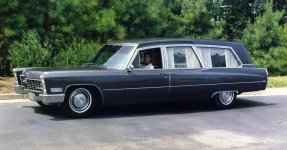Mike, I'm going to throw something out here that will hopefully help your cause with getting the seller to sell at your price. At the same time, it may give you pause. Please take this as my experience only, but I wanted to pass it along. My former 1967 Superior had the same 429 engine as does your pending '64. When driving long distances, especially in summer, I would notice a strong smell of motor oil. I had to keep adding oil. It wasn't leaking, but ultimately discovered it was backflowing out of the filler tube. The air is supposed to flow INTO the tube, not out of it. Over the years, several people had offered reasons why this happened, from bad block castings on 429's to soft oil rings that would ultimately let oil bypass the pistons.
One thing is for certain. I had gotten into the habit of spot-checking various 429 Cadillac engines over the years. I would stand on tip-toes, and peer STRAIGHT DOWN next to the oil filler spout. More often than not, I would see a pool of oil sitting on the top of the pan. This is exactly what my '67 did, and I'm making a guess that when you see this pooled oil, you're getting blowby at the pistons. I hope I didn't open a huge can of worms telling this story, but take it in the helpful spirit it's offered. Tom





